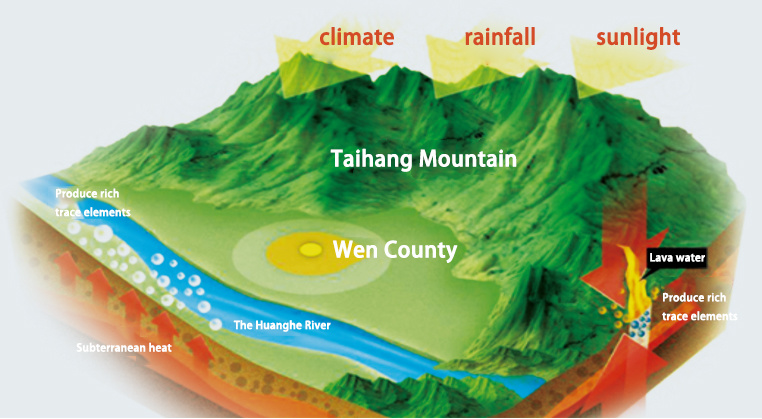Native to Huaichuan, it has become the food of immortals
According to the "Annals of Huaiqing Prefecture" by Qianlong, yams are used as medicine in the "Hanoi" (now known as Wenxian County, Henan Province) of Huaiqing Prefecture. Therefore, the superior yam is also known as "Huai yam", abbreviated as "Huaishan", and is also mistakenly referred to by many people as "Huaishan". Until now, in areas such as Guangdong, Fujian, Taiwan, and Hong Kong, with the exception of a few experts, most sellers still refer to their products as authentic "Huaishan" when selling yams, coming from Henan Province. Some even add that they refer to Jiaozuo in the Huaihe River basin in Henan Province, known as "Qinhuai" in the summer, later as "Huaizhou", "Huaimeng Road" in the Yuan Dynasty, and "Huaiqing Mansion" in the Ming and Qing dynasties.
The "Shennong Materia Medica Classic", "Tujing Materia Medica", and "Compendium of Materia Medica" all specifically indicate the yam mentioned, and the origin is "Huai". "When it comes to yams, it is said in" The Complete Book of Materia Medica "that" both northern and southern prefectures and counties are produced, and those who are Huaiqing are good. ". "Shennong's Classic of Materia Medica" also states that "yams are produced everywhere, with various real estate producers in Huaiqing, Henan Province being good.".
·It is better to take medicine for those who are pregnant between Huai and Meng—— "Salvation Materia Medica", published in 1406, was organized and compiled by Zhu Ju (1361-1425), the fifth son of Zhu Yuanzhang, the Emperor Taizu of the Ming Dynasty
·Dioscorea, although found in all prefectures, is considered good when used as medicine in Hanoi (formerly known as Huaiqing Prefecture)—— "Records of Huaiqing Prefecture", published in 1520, was written by He Tang (1474-1543), a historian of the Ming Dynasty.
·Both the northern and southern states and counties have their own products, but those who cherish and celebrate are good—— "Materia Medica Meng Quan", published in 1565, by Chen Jiamo (1521-1603), a famous doctor of the Ming Dynasty
·Chinese yam is commonly used in Huaiqing nowadays, so today's local medicine shops mostly use cultivated products from Huaiqing in Henan Province. It is specially called Huaishan yam and is sold as a famous medicinal material in distant and near times. It is also a product frequently prepared by medicine shops—— "Primitive Materia Medica", written in 1593 and published in 1612 by Li Zhongli, a medical scientist of the Ming Dynasty
·The yam is good in Huaiqing, Henan—— "Shoushi Baoyuan", published in 1615, was written by Gong Yanxian (1522-1619), a physician of the Great Inner Court during the Wanli Period of the Ming Dynasty
·In the Huaiqing Mountain, it is white, thin, and solid, and can be used as medicine—— "A Survey of Plant Names and Facts", published in 1848, was written by Wu Qijun (1789-1847), a botanist of the Qing Dynasty.

"If yams are used as medicine, they are good in Huaiqing, Henan.". According to national standards, the geographical range between 34.48 ° - 35.30 ° N and 112.02 ° - 113.38 ° E, namely, the yam produced in Wen County, Jiaozuo, belongs to the product of origin protected by the state.

Due to the Taihang Mountains in the north and the Yellow River in the south, Wen County is embraced by mountains and rivers, hence its name "Huai", also known as "Huai Chuan within 300 li". Here is the barrier of Taihang Mountain, which integrates the sun of the mountain and the yin of the water. The land is loose and fertile, with rapid drainage, abundant rainfall, excellent water quality, sufficient sunlight, a mild climate, and distinct four seasons, forming a unique natural condition and climate environment of "no drought in spring, no overheating in summer, no waterlogging in autumn, and no cold in winter.". The annual average temperature here is about 14 degrees Celsius, the annual average soil temperature is about 15 degrees Celsius, and the annual average precipitation is 600-700mm. It breeds the unique appearance and texture of the "four major Huaiyao", namely, yam, chrysanthemum, rehmannia, and achyranthes bidentata. Its unparalleled pharmacological and nourishing effects can be called the natural priceless treasure bestowed by nature on Jiaozuo, a hot land.









